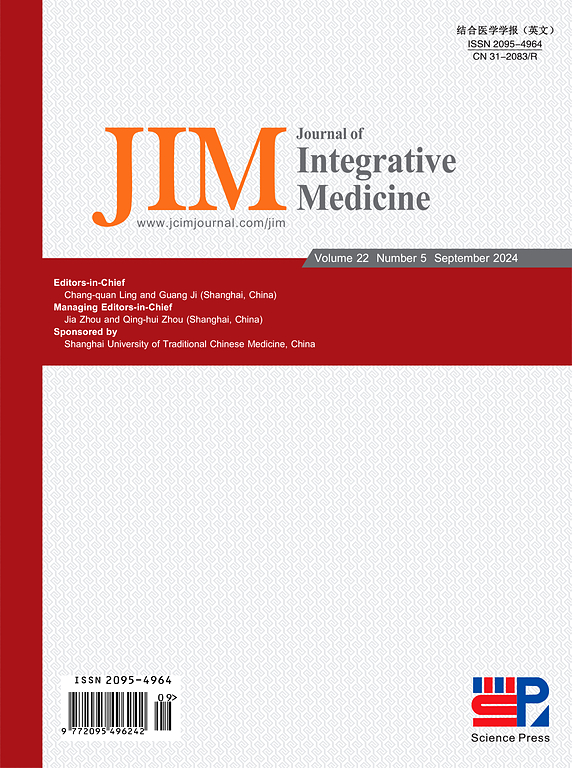Development of a machine learning-based risk prediction model for mild cognitive impairment with spleen-kidney deficiency syndrome in the elderly
IF 4
2区 医学
Q1 INTEGRATIVE & COMPLEMENTARY MEDICINE
引用次数: 0
Abstract
Objective
As an age-related neurodegenerative disease, the prevalence of mild cognitive impairment (MCI) increases with age. Within the framework of traditional Chinese medicine, spleen-kidney deficiency syndrome (SKDS) is recognized as the most frequent MCI subtype. Due to the covert and gradual onset of MCI, in community settings it poses a significant challenge for patients and their families to discern between typical aging and pathological changes. There exists an urgent need to devise a preliminary diagnostic tool designed for community-residing older adults with MCI attributed to SKDS (MCI-SKDS).
Methods
This investigation enrolled 312 elderly individuals diagnosed with MCI, who were randomly distributed into training and test datasets at a 3:1 ratio. Five machine learning methods, including logistic regression (LR), decision tree (DT), naive Bayes (NB), support vector machine (SVM), and gradient boosting (GB), were used to build a diagnostic prediction model for MCI-SKDS. Accuracy, sensitivity, specificity, precision, F1 score, and area under the curve were used to evaluate model performance. Furthermore, the clinical applicability of the model was evaluated through decision curve analysis (DCA).
Results
The accuracy, precision, specificity and F1 score of the DT model performed best in the training set (test set), with scores of 0.904 (0.845), 0.875 (0.795), 0.973 (0.875) and 0.973 (0.875). The sensitivity of the training set (test set) of the SVM model performed best among the five models with a score of 0.865 (0.821). The area under the curve of all five models was greater than 0.9 for the training dataset and greater than 0.8 for the test dataset. The DCA of all models showed good clinical application value. The study identified ten indicators that were significant predictors of MCI-SKDS.
Conclusion
The risk prediction index derived from machine learning for the MCI-SKDS prediction model is simple and practical; the model demonstrates good predictive value and clinical applicability, and the DT model had the best performance.
Please cite this article as: Ai YT, Zhou S, Wang M, Zheng TY, Hu H, Wang YC, Li YC, Wang XT, Zhou PJ. Development of a machine learning-based risk prediction model for mild cognitive impairment with spleen-kidney deficiency syndrome in the elderly. J Integr Med. 2025; 23(4): 390–397.
基于机器学习的老年人脾肾虚证轻度认知障碍风险预测模型的建立。
目的:轻度认知障碍(MCI)作为一种与年龄相关的神经退行性疾病,其患病率随着年龄的增长而增加。在中医框架内,脾肾虚证(SKDS)被认为是最常见的MCI亚型。由于MCI的发病隐蔽且缓慢,在社区环境中,患者及其家属很难区分典型的衰老和病理变化。目前迫切需要设计一种初步的诊断工具,用于社区居住的老年人因SKDS而导致的MCI (MCI-SKDS)。方法:本研究纳入312例诊断为轻度认知障碍的老年人,按3:1的比例随机分为训练组和测试组。采用逻辑回归(LR)、决策树(DT)、朴素贝叶斯(NB)、支持向量机(SVM)和梯度增强(GB) 5种机器学习方法构建MCI-SKDS诊断预测模型。准确度、灵敏度、特异度、精密度、F1评分和曲线下面积评价模型的性能。通过决策曲线分析(decision curve analysis, DCA)评价模型的临床适用性。结果:DT模型的准确度、精密度、特异性和F1得分在训练集(测试集)中表现最好,得分分别为0.904(0.845)、0.875(0.795)、0.973(0.875)和0.973(0.875)。SVM模型的训练集(测试集)的灵敏度在5个模型中表现最好,得分为0.865(0.821)。所有五个模型的曲线下面积对于训练数据集大于0.9,对于测试数据集大于0.8。所有模型的DCA均具有良好的临床应用价值。本研究确定了10个指标是MCI-SKDS的重要预测指标。结论:基于机器学习的MCI-SKDS预测模型风险预测指标简单实用;模型具有较好的预测价值和临床适用性,其中DT模型表现最好。本文署名:艾玉涛,周生,王敏,郑泰,胡华,王玉春,李玉春,王晓涛,周鹏杰。基于机器学习的老年人脾肾虚证轻度认知障碍风险预测模型的建立。集成医学[J];打印前Epub。
本文章由计算机程序翻译,如有差异,请以英文原文为准。
求助全文
约1分钟内获得全文
求助全文
来源期刊

Journal of Integrative Medicine-Jim
Medicine-Complementary and Alternative Medicine
CiteScore
9.20
自引率
4.20%
发文量
3319
期刊介绍:
The predecessor of JIM is the Journal of Chinese Integrative Medicine (Zhong Xi Yi Jie He Xue Bao). With this new, English-language publication, we are committed to make JIM an international platform for publishing high-quality papers on complementary and alternative medicine (CAM) and an open forum in which the different professions and international scholarly communities can exchange views, share research and their clinical experience, discuss CAM education, and confer about issues and problems in our various disciplines and in CAM as a whole in order to promote integrative medicine.
JIM is indexed/abstracted in: MEDLINE/PubMed, ScienceDirect, Emerging Sources Citation Index (ESCI), Scopus, Embase, Chemical Abstracts (CA), CAB Abstracts, EBSCO, WPRIM, JST China, Chinese Science Citation Database (CSCD), and China National Knowledge Infrastructure (CNKI).
JIM Editorial Office uses ThomsonReuters ScholarOne Manuscripts as submitting and review system (submission link: http://mc03.manuscriptcentral.com/jcim-en).
JIM is published bimonthly. Manuscripts submitted to JIM should be written in English. Article types include but are not limited to randomized controlled and pragmatic trials, translational and patient-centered effectiveness outcome studies, case series and reports, clinical trial protocols, preclinical and basic science studies, systematic reviews and meta-analyses, papers on methodology and CAM history or education, conference proceedings, editorials, commentaries, short communications, book reviews, and letters to the editor.
Our purpose is to publish a prestigious international journal for studies in integrative medicine. To achieve this aim, we seek to publish high-quality papers on any aspects of integrative medicine, such as acupuncture and traditional Chinese medicine, Ayurveda medicine, herbal medicine, homeopathy, nutrition, chiropractic, mind-body medicine, taichi, qigong, meditation, and any other modalities of CAM; our commitment to international scope ensures that research and progress from all regions of the world are widely covered. These ensure that articles published in JIM have the maximum exposure to the international scholarly community.
JIM can help its authors let their papers reach the widest possible range of readers, and let all those who share an interest in their research field be concerned with their study.
 求助内容:
求助内容: 应助结果提醒方式:
应助结果提醒方式:


